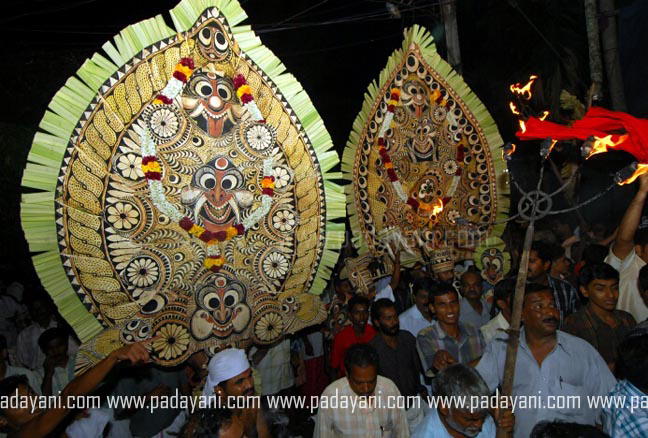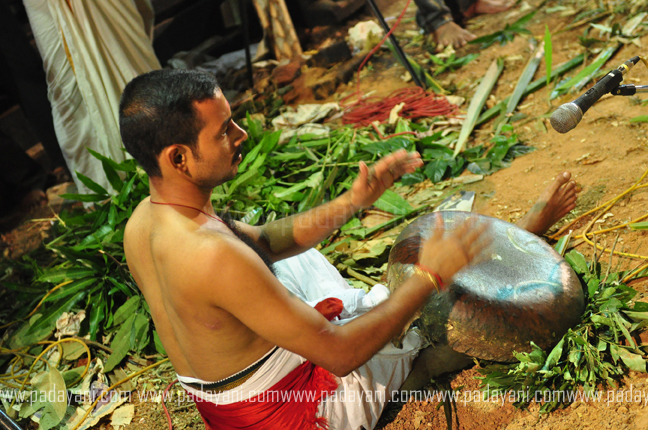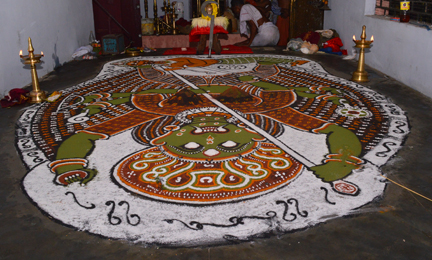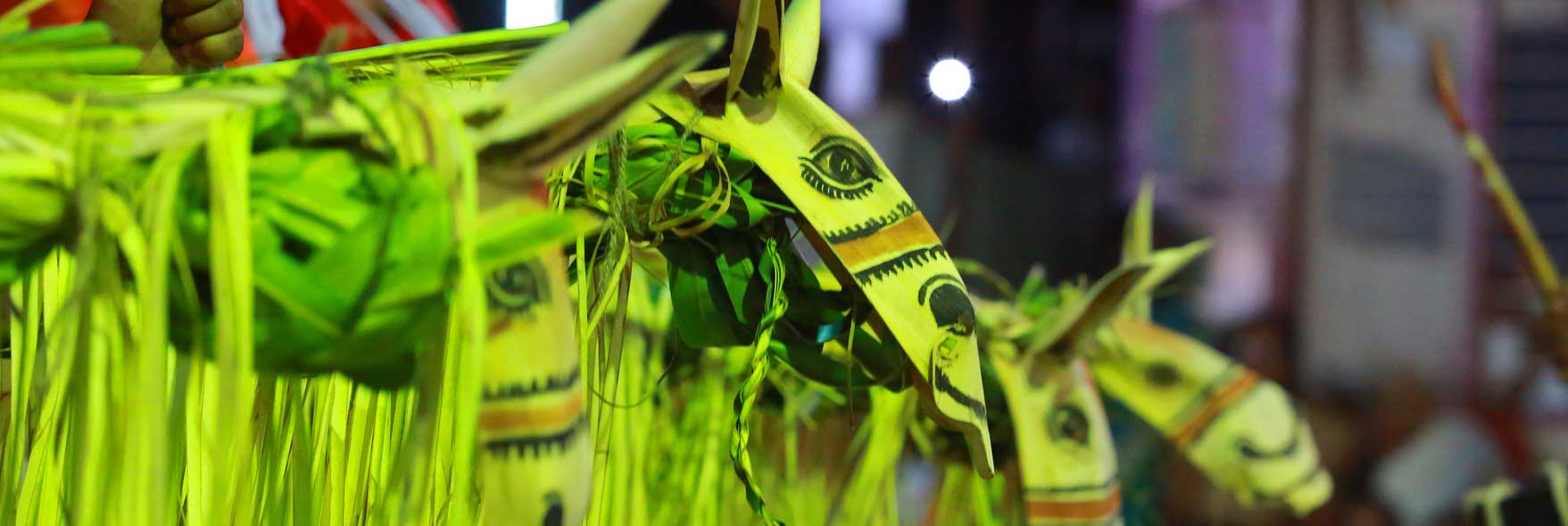Padayani
Padayani is the annual ritualistic festival celebrated in Bhadrakali temples of Central travancore zone with due dedications. It may be regarded as the remains of ancient Dravidian concept of God and the mode of worship, offering Rathi (lust), Raktham (Blood) and Lahari (intoxication). The very spirit of central travancore finds its appearance in Padayani as that of Malabar in Theyyam. All the Sixty Four art forms play vital role in Padayani. Actually it is the combination of music, dance , painting, satire etc. Padayani reflects the ancient socialist society before the Aryanization and Chathruvarnya, the four caste system. So, the whole village take active part in Padayani without any racial discriminations. Each and every Padayani Karappuram (centers or village celebrating Padayani) observe padayani in their own way, in different aspect such as observation of rituals, order of performance and span of Padayani days. Obviously, the difference noticed is huge.

Padayani is celebrated during the months of Kumbham, Meenam and Medam ( Approximately February, March and April). Kolamezhuthu, Kolamthullal, Kolappattu, Thappumelam, Vinodam- the satire part, are the essential parts of Padayani. Kolams are folk deities drawn on well processed green areca leaf sheath with natural colours. Kolappattu (lyrics) includes prayers, admirations and requests to the deities. Thappu is the ‘Asuravadya’ made by covering a round frame of Jacktree hardwood with buffalohide. Kolamthullal is the rhythmic footsteps and dance, which a performer makes in tune with the Kolappattu and the Thappumelam. Vinodam includes satire and protest targeting the social evils and vanities. Bearing Palakkolam singing Kolappatu, dancing with the thalam of thappu , the whole villagers pray to God to bring in prosperity, eradicate the ill effects of wicked deities, ensure good crops and so on. It is a way of worship with no intermediary between man and God. Further, we can see a life which is friendly to the nature and worshiping it without exploitation.
The myth behind Padayani
According to Hindu mythology, evolution of Padayani is related to the birth of Kali. Once an Asura(demon) named Darika delighted Lord Brahma through his hard practice of penance and gained blessings that, he would be killed only by a women. Darika went on with his atrocities. Failing to defend Darika, Devas approched Lord Shiva for help. Hearing the atrocities of Darika, Lord shiva kindled with anger and opened his third eye bursting out fire. It is from this third eye, Kaali was born. Accepting the request of ‘Devas’ and obeying the instruction of her father Shiva, Kaali left for the abode of Darika mounting herself on Vethal accompanied by ‘Koolee Ganam’. The fight between Darika and Kaali was really frightening. At the end of the battle, Kaali cut off his head. Holding head in her hand and with overwhelming anger she returned to Kailasam. To pacify her and to satisfy her lust for blood, Devas performed variety entertainments like dance, mimicry, dialogues and, comedies. But it did not work. As she was going through the Gopura , the goddess paused a while seeing the painting depicted angry Kaali and she smiled. She asked her father "who drew this?". Shiva answered, This was drawn by Kurup’ (Kurupu Kurichu"). She glanced at the Kalam(Painting) once more and burst into laughter. Attempts made by Lord Shiva and his Bhoothagana to pacify and delight kaali are imitated as such in Padayani celebration. Even today kalamezhuthum Pattum is strictly conducted in Kaali temples with it own ritualistic originality. Even now, Kurup ( a caste) draws the kalam.
As the people promised to offer their own blood, kaali became quiet and delighted. Padayani is celebrated annually for the protection and prosperity of the village and its people.
Introductory steps of Padayani
Choottu Veypu
This is the first step of Padayani. Each Padayanikkarappuram has its own traditional way of Choottuveyppu. Choottu is the tail end of coconut leaves (Thunchani) made in to a bundle. it is then lit from the lamp in the Sreekovil by the Poojari (the priest) is handed over to the Oorazhmakkaran. People with Kurava and arppuvili accompany him. After Performing Pradakshinam, the Choottu will the nbe placed at the Meenathemoola (South western corner) of the temple. After choottuveypu masters of Padayani (Padayani Ashanmar) beat Ganapathy and padivattam on warmed Thappu. There will be frequent Kathinavedi in the course of Thappu beating. Padayani calls out Devi with loud ‘Eee-hoo’ sounds. This is actually an invitation to Devi to witness Padyani. This function is called Vilichirakkal, Kottivilikkal or Pachathappum Kaimaniyum in certain places. After 3 hours since sunset. Veekan chenda (a peculiar type of chenda) is used in a particular rhythm and a howling sound is made around the kavu. This is called Pishachine Unarthal (Waking up the Devil) in Padayani.
Padayani
Thappumelam, Valyamelam, Kappoli

After certain days since Choottuveypu, Padayani commences. In some places Padayani begins with Thappumelam but in some other places it is with Valyamelam(The big rhythm). The system of valyamelam is very rare now. Kappoli is at the climax kalayam of melam. Padayanikkalam is situated at the very front of Kshethranada (temple entrance). Men holding leafy twigs with aarpuvili (making a certain type of noise) leap forward to the kalam from either sides and perform dances. At the same time already prepared Kolams are brought in procession to the Kalam in the light of the choottu kattas, accompanied by chendamelam and arppuvili. This is called eduthuvaravu. In tune with this melam, kolam performs kappoli. There will be Kathinavedi very frequently during Eduthuvaravu. After Ganapathi and Padivattom kolams go round the temple and finally come to the Kalam. Then the kolam artists place kolams there in the Padayanikkalam.
Thavadi
Footsteps taken with expertise in body movement following the rhythm of melam. Hand movements or gestures have no much importance in Thavadi. The main performer moves in front taking steps and sounding kaimani. Others follow him dancing in three folds.
Pannathavadi
On either side of the Thavadi dancers, people appear with masks holding models of chenda, Thappu and kaimani and take comic steps, imitating thavadi dancers. This performance is called Pannathavadi. It is regarded as a protest of people who were expelled from padayani as they had no excellence in the real thavadi.
Velichappadu
After thavadi, Velichappadu, a comedy character makes its appearance. In certain padayani grounds Velichappadu appears even before Thavadi. Next performance is Paradeshi. In an age where there was no press or the electronic media news were brought to the villages through ‘Paradeshis’. Comedy items are given more importance in Kurampala Padayani than that in other places. After the comedy items Kolams occupy the kalam. The order of performance is usually like this-- Kuthira, Ganapathi, Ganapathi Pishachu, Marutha, Madan, Yekshi, Kalan, Bhairavi. One important kolam comes to the kalam each day. But in many places, system of Koottakkolam (Conducting the performance of a group of kolams) is also followed.
Adavi
Adavi is the most important ritualistic function of Padayani which runs for several days. Routine ritualistic performances will be there on adavi day too. More details in Adavi Segment.
Valiya Padayani
Vallya Padayani is conducted on the day, which is regarded as the dearest one for the most helpful animal in farming activities i.e. the bullock. Models of bullocks created and are brought everywhere in the village in procession. Neighboring villagers are duly received and honoured. These are some common observations related to Vallya padayani.
Pooppada
This is to eradicate Gandharva badha from virgin girls. Dance of Gandharvan Kolam is seen staged in some places. Piniyal holds the Arecanut inflorescence, Maranpattu is sung. The whole observation is done in an atmosphere of aarpu, kurava etc. Comedy item, Kaniyan Purappadu is also performed along with pooppada.
Nayattum Padayum
It is performed on the day following Adavi. Animals which comes to the cultivated field were once driven away with the help of dog and by lighting flames. Nayattum Padayum (The Hunting and the army) can be considered as the imitation of this practice. Ayyappa charitham ( story of Lord ayyappa) is sung in Nayattum Padayum. Pulikkolam(tiger), naykkolam (dog), Karadikkolam (bear) etc. are associated with this item.
Mangalakkolam
Mangalakkolam comes on Vallya Padayani day which is otherwise called Nirthu Padeni. When all kolam finish their performance on Vallya padeni day, it will be day break. Mangalakkolam beg pardon kavilamma for the faults and problems that might have happened while staging padayani. Bhairavi and Kanjiramala are often regarded as Mangalakolam. Dance of Mangalakkolam comes to an end only after day break. After that samarppana gadyam is chanted and kolam mask is removed.
In Kurampala Padayani, after the performance of Bhairavi, all the wicked deities are attracted and favoured showing a black hen. Then they are led to the chiramudi along with the kolam. Chiramudi is a place with a plenty of pinaple plants, Ilanji trees, Yakshippana, Pala trees etc. Karinkozhi (black hen) is offered as bali cutting by its neck. Mannan performs some magic rituals. Then the kolam is hung on a Palamaram. Without looking back, all leave chiramudi.
Chattathekkolam
This kolam comes after Mangalakkolam. The kolam, as its name suggests, is mounted on a chattam, a wooden platform on wheels. On each face of this kolam, will be a lighted torch and a bell. This is otherwise called Ayiramaniyan Kolam (Kolam with thousand bells). This kolam is cut made using thousand areca leaf sheaths. Chattathekkolam is performed only associated with Othara Padayani.
Kalamezhuthum Pattum
Kalamezhuthum Pattum is a related with padayani. It is a Dravidian way of worship. It is believed that lord Subrahmanya draw the most fearful form of Kaali for the first time. When saw that, Kali asked Lord Shiva , who draw it. Shiva answered Kurup draw this. Even today Bhadrakaali form is drawn using ‘Panchavarnappodi’ (five types of natural colour powders) by members of the caste division, Kurup. Kaali figure thus drawn has sword, Sharp knife, Arrow, bow, Chakram and gada in hands. Number of hands varies as four, eight, sixteen, thirty two, sixty four and so on. Eighteen colour shades are applied in kalamezhuthu, using panchavarnapodi and their rare combinations. Red colour can be created by mixing equal quantities of lime and turmeric powder. Powdered rice, Vakayila powder, charcoal are used for creating white, green and black colours respectively. There are special and unique regional techniques and calculations for the preparation, the right proportion in colour combination and for deciding the quantity of colour powders to be taken for each Kalam in accordance with their size. The powder is taken in a special way with the thumb and forefinger and is then made fall through the space between fingers to draw the Kalam.

Kalamezhuthu, Pattu and Kuruthy are the introductory steps of padayani. Kalamezhuthu is done on Tuesday or Friday just prior to the village visit (Paraykkezhunnallipp) of Devi. Paraykkezhunnallippu generally commences on Aswathy, Bharani or Karthika day customarily. The ritualistic function Kuruthy is there seen associated with Kalamezhuthu. In old days blood was offered in Kuruthy. After Aryanization, instead of blood Aratham, a red coloured solution consisting lime and turmeric, is being offered as kuruthy. Offerings of velichappadu, through whom Devi is believed to speaks, is an important ritual in kuruthy. In some places Oorali, person belonging to Kurava race, performs this pooja instead of velichappadu. In some places Oorali thullal ( a certain type of footsteps performed by the oorali) is regarded as the first step of padayani.
Paraykkezhunnallippu
Devi, the village deity, visits the houses in a procession, seating herself on a Jeevatha accompanied by Chenda and multicoloured decorated umbrellas. Thus she observes the prosperity and poverty of her children. Villagers receive Devi with Nirapara or Anpoli. In some houses, people accompanying Devi will be given food, sweets or whatever they have. Showering graces on villagers, taking steps with Pancharimelam, Devi finds her way back to the temple finishing Paraykkezhunnallippu extending several days.
Neelam Peroor Pooram Padayani
Pally Bhagavathi Temple, Neelamperoor has a history of about 1700 yrs and it is one of the few relics of the Buddhist culture in Kerala. The principal deity of the temple is Goddess Vanadurga. The festivals of the temple are two in number- the ten day festival in the solar month meenam with its nineth day falling on pooram and the pooram padayani which starts from the day next to Thiruvonam in Chingam ( the first solar month of the Keralite calendar ) and lasts till Pooram, the birth day of Devi.
Pooram Padayani of this temple is a rare and unparalleled festival because it represents a synthesis of the Buddhist and Hindu cultures. It is strikingly similar to the Buddhist festival which Fahiyan, the Chinese traveler saw in Padaliputra (now, Patna in Bihar). It also resembles the ceremonies held in Sreemoolavarom which was once a Buddhist centre in Kerala,. The Pooram Padayani is characterized by the display of exquisitely decorated effigies of Swans, Bhima, Ravana, Yakshi,Elephant etc. These are offerings of the devotees for the fulfillment of their desires needs and solving their problems. Making of these effigies need consummate craftsmanship. About one lakh rupees is needed for the construction of the Big Swan. The cost of conducting a Padayani is shooting up each year and the organizers are facing problems in raising the funds. Donations made by the local people and various organizations are the main source of money for meeting the expenditure
Padayani begins at 10 p.m on the avittam day with prayers. Flames are received from the priest. With this flames devotees set fire to the bundles of coconut leaves. With these bundles in hand they move to the monument of Cheraman perumal at the western side. After receiving his symbolic sanction, they start padayani. This continues for the first four days. The next four days are characterised by Kudapadayani which consists of floral decorations on umbrella-shapes made from the stems of coconut leaves. From the eighth day to twelth effigies made out of green leaves of jackfruit trees are offered. The effigies displayed for the twelth day are made of the fibrous stem of plantains or slender leaves of coconut stems. The last two days are characterised by the display of swans (Annams) which are made of plantain stems and slender leaves of coconut trees with floral decorations. The highlight of the days is of course the offering of the big swan to propitiate the deity.
On the final day a smith breaks a coconut and turns it round. On the basis of this he makes some predictions. The temple closes at 10 P.M and then starts what is known as Kudampooja. The padayani is characterised by Thothakali, a rhythmic dance in accordance with songs from the folklore and the beating of the drums. Devotees arrange themselves round the big fire at the centre twirling small clothes in an artistic pattern and dance. Spectators from different parts of the country throng to the place to see this rare artistic form. The most spectacular of all is the display of the BIG SWAN which is about 45 feet high. Other swans and fully decorated effigies enhance the beauty of the scene.
When the padayani is over, people disperse in different directions. The gurusi offered by a specially chosen devotee who has undergone austeries for several days with penance and meditation (matter (neelamperoor) from Temple web)
Ponadu Choottu Padayani
This is the annual festival at the ancient Bhagavathy Temple in Meenachil taluk. Bunches of dry palm fronds (chootu) are lit and carried in procession around the temple before the performances. Padayani performers then hit each other with the burning chootu.
Conclusion
Padayani at each place has its own special features. Even the rituals vary much as we move from one village to the other. In certain places Velichappadu appears in the kalam after all ritualistic performances. In some places Kuruthy takes places after padayani. Appearance of Konan, a comedy character, after the Kalamozhiyal of kolam, the system of singing Devi worship songs by people in the tune of ‘Vanchippattu’, Pakal Padayani ( Padayani during day time) on Pathamudayam Day (Medam 10th) without kolam performance, Thattummekkali with songs of Lord Shiva staging on Kalatthattu Parayan thullal, Seethankan thullal, Aattakkoppu, Kalamezhuthu, Aapinteem Vilakkum, Sending back Devi after Padayani (Kottikkettal), Foretellling matter on the basis of the signs seen on cutting coconut and thus go on the variations in Padayani in various padayani villages. The afore detailed are the descriptions account for all such variations in additions to the common features of Padayani.

